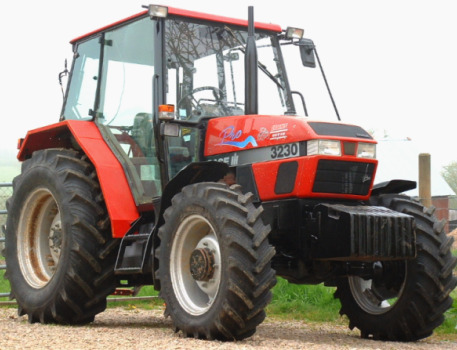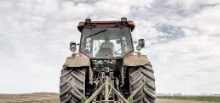________________________________________________________________________________________
| Home / Farm Tractors / Case IH Tractors / Case IH 3230 |
Case IH 3230 Troubleshooting
 The
Case International 3230 is a 3200-series utility tractor. This model was
manufactured from 1994 to 1997. The IH 3230 tractor is powered by Case D206
four-cylinder liquid-cooled diesel engine with operating power of 56.1 Hp (41.8
kw) and 220 Nm (163.2 lb-ft) of max torque at 1400 rpm.
The
Case International 3230 is a 3200-series utility tractor. This model was
manufactured from 1994 to 1997. The IH 3230 tractor is powered by Case D206
four-cylinder liquid-cooled diesel engine with operating power of 56.1 Hp (41.8
kw) and 220 Nm (163.2 lb-ft) of max torque at 1400 rpm.
The Case IH 3230 is fitted with two types of transmission. Type 1: 8x4 synchromesh transmission. Type 2: partial powershift transmission with 16 forward and 8 reverse gears. The maximum travel speed is 15.7mph / 25.2 km/h (forward) and 4.8 mph / 7.9 km/h (reverse).
The open center hydraulic system includes a gear pump with fluid flow rate of 15,6 gpm (59 lpm). The main relief pressure is 175 bar (2500 psi). The two-wheel drive tractors are equipped with 7.50x16 front tyres and 16.9x28 rear tyres. The 8.3x24 front tyres and 23.1x34 rear tyres fit four-wheel drive models. The wheelbase is 84.5 inches (2140 mm) for 2WD (4x2) models and 88 inches (2230 mm) for 4WD (4x4) models.
| Diesel Engine Troubleshooting |
| Engine hard to start or won't start |
Air in fuel system - Bleed fuel system.
Clogged fuel filter - Filter maintenance required.
Dirty or damaged injection nozzles - Change fuel injection nozzles.
Dirt or water in fuel system - Drain water or flush dirt from the system.
Incorrect valve clearance - Need to adjust valve clearance.
Fuel injection pump is not working correctly - Install a new pump or rebuild.
| Engine starts but then stops |
Intake air restriction - Air filter maintenance required.
Fuel filter plugging - Service the filter.
Problems with fuel injection pump tightness - Inspect fuel injection pump for leaks.
Fuel injectors are faulty or clogged - Replace or clean fuel injectors.
Fuel injection pump failure - Replace injection pump or repair it.
| Engine stalls while running |
Coolant temperature is low - Normalize the temperature by warming up the engine.
Fuel filter plugging - Replace filter element.
There is air in the fuel system - Bleed the system.
Clogged injection nozzle - Service or change injection nozzles.
Improper fuel injection timing - Set the fuel pump timing correctly.
| Engine stops when idling |
Too low idle RPM - Normalize low idle speed.
Fuel injection pump is faulty - Repair or install new pump.
Fuel injector fault - Inspect fuel injectors and change as required.
Valve clearance is out of adjustment - Have it adjusted.
| Reduced engine power |
Dirty air filter element - Clean or change the filter.
Faulty or dirty injection nozzles - Service or change injection nozzles.
Fuel injection pressure is wrong - Test fuel injection pressure and adjust it correctly.
Valve clearance is out of adjustment - Adjust valve clearance.
Low idle speed setting is not correct - Correct the settings.
Dirt in the fuel lines or hoses - Service fuel hoses and lines.
Cylinder head gasket is blown - Gasket should be replaced.
Piston rings are worn or defective - Piston rings need to be replaced.
| Engine is overheated |
Insufficient coolant - Add coolant and check the components of cooling system.
Engine oil insufficient - Checking oil level and add if necessary.
Dirty radiator fins or defective radiator cap - Replace cap or clean radiator.
Fan belt is worn or faulty - Change the fan belt.
Engine overload - Reduce load or shift to lower gear.
| Insufficient oil pressure |
Low oil level - Add oil as required.
Oil filter clogged - Change or clean engine oil filter element.
Different type of engine oil - Use the specified type of engine oil.
Incorrect crankshaft bearing oil clearance - Bearings need to be reinstalled.
Oil pump is worn or damaged - Replace as required.
| Engine knocks or noises |
Engine oil level low - Fill up the engine oil.
Engine is not fully warmed up - Normalize the temperature by warming up the engine.
Improper setting of fuel injection pump timing - Adjust as recommended.
Incorrect low idle setting - Need to adjust idle speed.
Fuel injectors are faulty or clogged - Inspect fuel injectors and change as required.
Faulty or misaligned connecting rod - Need to replace or align the connecting rod.
Worn or broken pistons - Replace the pistons.
| Transmission Troubleshooting |
| Low transmission oil pressure |
Lack of transmission fluid - Add fluid to the transmission housing.
Dirty transmission fluid filter element (if equipped) - Clean or change transmission fluid filter.
Relief valve is damaged - Replace relief valve.
| Transmission is making noise |
Lack of transmission fluid - Need to add transmission fluid.
Transmission oil is contaminated - Fill up with fresh transmission oil.
Gears are damaged or backlash is incorrect - Replace defective gears or set backlash properly.
Bearings are cracked or worn - Change faulty bearings.
Worn or damaged gear shift forks - Change the shift forks.
Shaft splines are worn or damaged - Change defective shaft.
| Difficult to shift gears |
Gear shift linkage is corroded or worn - Replace or lubricate the shift linkage.
Shift forks are worn or bent - Change defective shift forks.
Worn out parts of the gearshift mechanism - Replace worn parts.
Malfunction or incorrect clutch adjustment - Adjust correctly or replace.
| Transmission oil leakage |
Too much oil in transmission - Drain the excess oil.
Seals or gaskets are worn - Install new components.
| Hydraulics Troubleshooting |
| Hydraulic oil pressure too low |
Hydraulic fluid is insufficient - Checking hydraulic fluid level and add if necessary.
Hydraulic oil filter is clogged - Install a new hydraulic filter element.
Defective hydraulic pump - Repair or replace hydraulic oil pump.
Hydraulic spool valve block is not adjusted properly - The spool valve should be properly adjusted.
Defective hydraulic cylinder - Replace or repair hydraulic cylinder.
Leaks in hydraulic lines - Inspect the system for leaks and fix it.
| Hydraulic system overheats |
Main relief valve malfunctioning - Replace relief valve.
Improper type of hydraulic fluid - The correct type of fluid must be used.
Hydraulic fluid contamination - Change hydraulic fluid.
There is air in the hydraulic system - Bleed hydraulic system.
| 3-point hitch won't lift or lifts slowly |
Excessive load on hitch - Reduce the load is required.
Hydraulic oil level low - Need to add oil.
Dirty hydraulic fluid filter - Clean or change hydraulic filter.
Faulty hydraulic pump - Replace or repair hydraulic oil pump.
Main relief valve failure - Relief valve must be changed.
Damaged hydraulic control valve - Install a new valve or repair it.
Broken hydraulic cylinder - Repair or replace hydraulic cylinder.
Loose or broken suction line - Tighten the pipe or replace it.
| 3-point hitch won't lower or lowers slowly |
Incorrect setting hydraulic spool valve - Use the correct setting.
Defective hydraulic cylinder - Repair or change hydraulic cylinder.
Unadjusted hitch - The 3-point hitch must be adjusted.
Worn hitch rock shaft - Replace the shaft.
| Hitch drop or lift is jerky |
There is air in the hydraulic system - Bleed hydraulic system.
Contaminated hydraulic oil - Change hydraulic oil.
Hydraulic pump failure - Install a new hydraulic fluid pump.
Defective hydraulic control valve - Repair or change the valve.
Broken hydraulic cylinder - Install a new hydraulic cylinder or repair it.
| Steering Troubleshooting |
| Steering is stiff |
Improperly fitted or damaged steering column - Refit or change the steering column.
Air lock in the steering system - Bleed the system of air.
Incorrect toe-in - Adjust toe-in wheels.
Tyre pressure is uneven - Adjust the tyre pressure.
Steering pump is faulty - Repair or replace steering pump.
Pump flow control valve is stuck or damaged - Replace or service control valve.
Not enough steering fluid - Fill up steering fluid to required level.
| Excessive steering wheel play |
Steering column shaft or coupling is worn out - Change faulty part.
Steering pump is worn - Install a new steering pump.
Loose or worn steering linkage components - Replace or repair steering linkage.
| Front wheels wander to left or right |
Front tyres are worn unevenly - Install new tyres.
Improper toe-in - Adjust toe-in wheels.
Steering linkage parts are loose or worn - Repair or replace steering linkage.
Damaged or improperly adjusted or worn front wheel bearings - Adjust properly or change bearings.
| Electrical Troubleshooting |
| Battery does not charge |
Electrical wire connections are loose or corroded - Clean or tighten connections.
Defective battery terminal clamps - Change terminal clamps.
Battery is worn - Battery replacement required.
Loose or damaged belt - Belt needs to be adjusted or replaced.
| Starter cranks slow |
Battery capacity is low - Battery is drained, charge it.
Battery drains quickly - Service or replace the battery.
Battery terminals are corroded or wires are disconnected - Check wiring and clean or replace terminals.
| Starter motor won't turn |
Battery is discharged or worn - Recharge or replace battery.
Battery wiring is disconnected or improperly connected - Inspect wiring and connect as required.
Battery power is low - Charge the battery.
Starter motor failure - Change or repair starter.
________________________________________________________________________________________
________________________________________________________________________________________
| Farm Tractors Technical Specifications |
